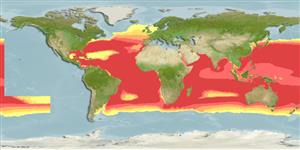Environment: milieu / climate zone / depth range / distribution range
Οικολογία
Θαλασσινό(ά); ωκεανόδρομο(ς) (Ref. 51243). Subtropical
Central Atlantic: Southwards to South Africa in the eastern part. Records outside central western Atlantic should be different species (H.Ho, pers.comm. 2/2017).
All reports in the Mediterranean Sea before 2017 are misidentifications for Bregmaceros nectabanus Whitley, 1941.
Μέγεθος / Βάρος / Age
Maturity: Lm ? range ? - ? cm
Max length : 7.8 cm TL αρσενικό/απροσδιόριστο; (Ref. 40727); common length : 6.0 cm SL αρσενικό/απροσδιόριστο; (Ref. 47377)
Short description
Κλείδες προσδιορισμού | Μορφολογία | Μορφομετρία
Ραχιαίες άκανθες (συνολικά) : 0; Μαλακές ραχιαίες ακτίνες (συνολικά) : 48 - 57; Εδρικές άκανθες: 0; Μαλακές εδρικές ακτίνες: 49 - 60; Σπόνδυλοι: 49 - 57. The head is of moderate size; eyes large; snout rounded. The first dorsal fin is well separated from the second dorsal fin. The body is brownish above, silvery below.
Generally oceanic. Feed on zooplankton and phytoplankton, especially crustaceans (Ref. 6735). Oviparous, with planktonic eggs and larvae (Ref. 6735).
Life cycle and mating behavior
Γεννητική Ωρίμανση | Αναπαραγωγή | Γεννοβολία | Αβγά | Γονιμότητα | Προνύμφες
Cohen, D.M., 1990. Bregmacerotidae. p. 524-525. In J.C. Quero, J.C. Hureau, C. Karrer, A. Post and L. Saldanha (eds.) Check-list of the fishes of the eastern tropical Atlantic (CLOFETA). JNICT, Lisbon; SEI, Paris; and UNESCO, Paris. Vol. 2. (Ref. 4496)
IUCN Red List Status (Ref. 130435: Version 2024-2)
Threat to humans
Harmless
Human uses
Εργαλεία
Special reports
Download XML
Διαδικτυακές πηγές
Estimates based on models
Preferred temperature (Ref.
123201): 15.1 - 27.6, mean 22.4 °C (based on 1483 cells).
Phylogenetic diversity index (Ref.
82804): PD
50 = 0.5001 [Uniqueness, from 0.5 = low to 2.0 = high].
Bayesian length-weight: a=0.00380 (0.00219 - 0.00659), b=3.19 (3.03 - 3.35), in cm total length, based on LWR estimates for this species & (Sub)family-body (Ref.
93245).
Τροφικό Επίπεδο (Ref.
69278): 2.8 ±0.24 se; based on food items.
Fishing Vulnerability (Ref.
59153): Low vulnerability (10 of 100).
